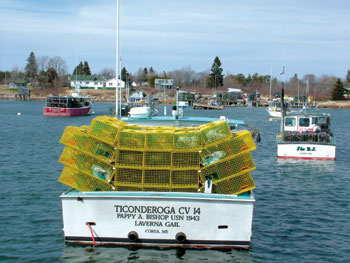Lobster: Good News, Bad News
by Laurie Schreiber
|
With so much of the lobster harvest coming from the younger end of the legal-size population, managers have issued a warning about the future of the fishery.
The Atlantic States Marine Fisheries Commission’s (ASMFC) 2005 peer-reviewed stock assessment for American lobster, presented to the American Lobster Board in October, uses strong language to sum up the concerns of fishery managers, saying, “it is the future that leads to the greatest peril for the lobster resource. It would only take a sequence of two to three years of poor recruitment to collapse any component of the lobster resource, and the appearance of extremely low recruitments in recent times in some areas is a cause of concern if not alarm. Until the harvest strategy is revised to provide a buffer of mature adult spawners to cover the bad times, lobster fishery management is a time bomb waiting to explode, its fuse lit by recruitment failure.”
The lobster resource presents a mixed picture, the report says. Stock abundance is stable throughout most of the Gulf of Maine (GOM) and Georges Bank (GB).
But abundance and recruitment in Southern New England (SNE) is low. In Massachusetts Bay and Stellwagen Bank, known as Area 514 on the assessment grid, abundance and recruitment are decreasing.
|

The new lobster stock assessment says the Gulf of Maine is in the best shape of the three units the areas were grouped into. Recruitment remains an issue in the eyes of the ASMFC and harvest strategy revision is being suggested. Photo: Fishermen's Voice |
|
|
|
|
Split Bamboo
by Mike Crowe
|
A chance encounter on a stagecoach traveling from Bangor to Monson in 1857 curiously found its way into the written record. For some, the two travelers mirror the two sides of the state’s attraction. That trip today is a two-hour ride in a car. Back then, it was a few spine pounding days, over the rocks, potholes and ruts of the typical dirt road. Henry David Thoreau, American writer and philosopher, wrote of this encounter in The Maine Woods, a book about his trips to Maine.
Thoreau met professional hunters headed for the woods north of Monson and Moosehead Lake, on that stage. One of them was Hiram L. Leonard. Professional hunters sold moose, bear and deer meat to logging camps throughout northern Maine. They lived much of the time in the deep woods for long stretches and they usually looked it. Their lives, at least while they were hunting, were on the fringes of society. Many didn’t pay much attention to appearances, behavioral norms or personal hygiene. They didn’t have to.
Thoreau’s encounter with Leonard was with an anomaly, possibly “the” anomaly of Maine’s professional hunters. Thoreau’s three paragraphs about it best describe the man sitting across from him in that rumbling stagecoach. Leonard’s name is still recognized around the world by some, while not much is known of his early life by most. Thoreau preserved a snapshot of the man.
“The stage was crowded all the way and I attended the more to my fellow travelers. If you looked inside this coach you would have thought that we were prepared to run the gauntlet of a band of robbers, for there were four or five guns on the front seat, the Indian’s included, and one or two on the back one, each man holding his darling in his arms. One had a gun which carried 12 to a pound. It appeared that this party of hunters was going our way, but much farther down the Allegash and St. John, and thence up some other stream, and across to the Ristigouche and the Bay of Chaleur, to be gone six weeks. They had canoes, axes, and supplies deposited some distance along the route. They carried flour, and were to have new bread every day.
continue
|
| Hiram L. Leonard in hunting garb, with a knife at his chest and an axe in his belt. A highly skilled and regarded professional hunter, he is remembered today for other skills. His intent look, hand on the rifle mechanism and posture suggest a heightened awareness of the camera in its early days. Photo courtesy Merritt Hawes |
|
|
|
|
|
  
|
|

